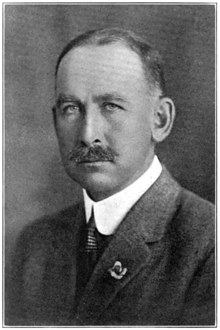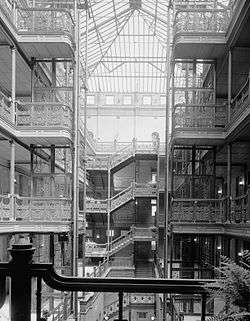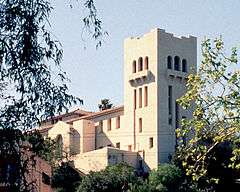Sumner Hunt
| Sumner P. Hunt | |
|---|---|
 | |
| Born |
May 8, 1865 Brooklyn, New York |
| Died |
November 19, 1938 Los Angeles, California |
| Nationality | American |
| Occupation | Architect |
| Practice |
Sole practitioner, and in partnerships of: Eisen and Hunt (1895–1899), Hunt and Eager (1899–1908), Hunt, Eager & Burns (1908–1910), Hunt and Burns (1910–1930) |
| Buildings | Bradbury Building, Southwest Museum |
| Projects | Los Angeles region, California |
| Design | Historicist−Revival architecture styles |
Sumner P. Hunt (Brooklyn, NY, May 8, 1865 – Los Angeles, CA, November 19, 1938) was an architect in Los Angeles from 1889 to the 1930s. On January 21, 1892, he married Mary Hancock Chapman, January 21, 1892. They had a daughter Louise Hunt.
Life and career
Hunt initially apprenticed with and worked for Clarence B. Cutler in Troy, NY from 1879–1887, and in Cutler’s office in New York, NY until 1889.
In Los Angeles, where he moved in 1889, he worked for Eugene Caulkin and Sidney I. Haas (designers of the 1888 Los Angeles City Hall) from 1889–1892. Hunt moved to his own practice in 1893, the year he was hired by Louis Bradbury to design the Bradbury Building. In 1895 Hunt formed a partnership with Theodore A. Eisen. Eisen & Hunt continued until 1899.
In 1899 Hunt went into partnership with A. Wesley Eager. Hunt & Eager lasted until 1908, at which point Silas Reese Burns joined the firm, which became Hunt, Eager & Burns. In 1910 Eager retired, and the firm became known as Hunt & Burns, a partnership that lasted until 1930.
In her essay on Hunt's early work, Karen J. Weitze notes that he may have been involved in the design of Sidney Haas’s Moorish- and Mission-revival designs for the California Building at the 1893 World’s Columbian Exposition in Chicago. Hunt adopted the Mission Revival style for the Froebel Institute, also known as Casa de Rosas (1893), and “became a leading proponent of Hispanicism, a fact that was clearly reflected in his Southern California Building at the California Midwinter Exhibition” in 1894.[1]
Hunt joined Charles Lummis and the architect Arthur B. Benton in 1894 to found the California Landmarks Club, with the purpose of saving Southern California’s mission buildings. The following year Lummis mentioned some of Hunt’s architecture in an article in Land of Sunshine, in which he advocated for turning Los Angeles from a beautiful city into a picturesque one. In the same article Lummis attributed the plan of the Bradbury building to Hunt.[2]
Practice
.jpg)
Projects designed by Hunt, and by his architectural partnerships, include: [3] [4]
- Casa de Rosas — 1893.
The Press Reference Library (Los Angeles: Los Angeles Examiner, 1912), p,. 82, lists the following buildings for Hunt, although he very likely designed them in partnership:
- Los Angeles Country Club (Hunt & Burns)
- Annandale Country Club
- Ebell Club House (originally at Figueroa and Eighteenth)
- Casa de Rosas (Froebel Institute), Adams and Hoover
- J. F. Francis residence at Ninth and Bonnie Brae
- W. G. Kerckhoff residence on Adams (Hunt & Eager)
- Ross Clark residence on Adams
- William Lacy residence on Wilshire
- H. W. O’Melveny residence on Wilshire
- T. L. Duque residence at New Hampshire and Seventh
- Eisen and Hunt (1895–1899)
- Bradbury Building — 1898, Downtown Los Angeles
- Lummis House (El Alisal) — 1898, Arroyo Seco, Los Angeles
- Hunt and Eager (1899–1908)
- Edward Doheny mansion — 1899, Chester Place, Los Angeles.
- John G. Bullock House — 1906, Los Angeles
- Echo Park Clubhouse — 1908, Echo Park, Los Angeles
- W. G. Kerckhoff Hall — 1908, West Adams, Los Angeles
According to Our Architecture: Morgan & Walls, John Parkinson, Hunt & Eager, compiled by J. L. Le Berthon (Los Angeles, CA: J. L. Le Berthon, 1904), Hunt & Eager were responsible for the following structures:
- Raymond Hotel, Pasadena (original plans by Thomas William Parkes, revised and executed by Hunt & Eager)
- Hollywood Cemetery entrance
- Santa Barbara apartment house
- Marion apartment house
- F. W. Braun Residence
- H. W. Vermillion residence
- Sumner P. Hunt (Hunt Hancock) residence on Severance Street, Los Angeles
- A. Wesley Eager residence
- Foster residence
- Beville residence, Hollywood
- Cumnock School of Expression on Vermont
- Strassburg residence
- Vail residence
- Bragdon residence
- Armstrong residence
- Gillis residence
- Brown-Janvier residence
- A. Herman residence
- M. E. Moore residence
- R. S. Crombie residence
- S. K. Lindley residence
- Theodore Weiss residence
- F. K. Wilson residence
- Storrow residence
- Sartori residence
- Fremont residence
- Judge Knight residence
- Hunt and Burns (1910–1930)
- Pierpont Inn — 1910, Ventura, California
- Glen Tavern Inn — 1910, Santa Paula, California
- Los Angeles Country Club clubhouse — 1911, Los Angeles
- Scottish Rite Temple — 1911, Santa Fe, New Mexico
- Vermont Square Branch library — 1912, South Los Angeles
- Highland Park Ebell Club — 1913, Highland Park, Los Angeles
- Southwest Museum — 1914, Mount Washington, Los Angeles
- Los Angeles Tennis Club — 1921, Los Angeles
- Ventura County Country Club (Saticoy Country Club) — 1921
- Automobile Club of Southern California headquarters — 1923, Exposition Park, Los Angeles
- Virginia Robinson Gardens Pool Pavilion — 1924, Beverly Hills, California
- Ebell of Los Angeles clubhouse — 1927, Wilshire Boulevard, Los Angeles
- Balch Hall — 1929, Scripps College campus in Claremont, California. A gift of Mr. and Mrs. Allan C. Balch, in honor of trustee Janet Jacks Balch.

See also
- Sumner Hunt buildings
References
- ↑ Karen J. Weitze, “Sumner P. Hunt” in Toward a Simpler Way of Life: The Arts & Crafts Architects of California, ed. Robert Winter (Berkeley: University of California Press, 1997), 184.
- ↑ Charles Fletcher Lumis, "The Lesson of the Adobve," Land of Sunshine 2 (March 1895), 67.
- ↑ Invisiblemanor.com: buildings by Sumner Hunt, with chronology
- ↑ Starr, Kevin (1991). Material Dreams: Southern California Through the 1920s. Oxford University Press. p. 202.
External links
- Invisiblemanor.com: Sumner Hunt :: Los Angeles Architect
- Flickr: Sumner P. Hunt, Architect gallery — album of Hunt's buildings.
- Los Angeles Conservancy — Sumner P. Hunt
- Friends of the Southwest Museum

